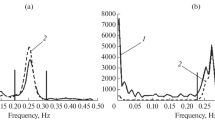Abstract
The normality (Gaussian property) and stationarity of the cardiac Doppler blood-flow signal were evaluated on short-time segments distributed over the cardiac cycle. The basic approaches used to perform statistical tests on the nonstationary and quasiperiodic cardiac Doppler signal are presented. The results obtained from the data of ten patients having a normal aortic valve and ten patients having a stenotic valve indicate that a complex Gaussian random process is an acceptable approximation for the clinical cardiac Doppler signal. For segments of 10 ms or less, 82 per cent of them were accepted to be stationary with a significance level of 0.05, whereas for durations greater than 40 ms, the percentage of stationary segments was less than 75 per cent. It was concluded that the 10ms window generally used in practice is a good choice for Doppler spectrogram estimation, but a shorter time interval would be preferable.
Similar content being viewed by others
References
Angelsen, B. A. J. (1980) A theoretical study of the scattering of ultrasound from blood.IEEE Trans.,BME-27, 61–67.
Atkinson, P. andWoodcock, J. P. (1982)Doppler ultrasound and its use in clinical measurement. Academic Press, New York.
Bendat, J. S. andPiersol, A. G. (1986)Random data: analysis and measurement procedure. (Revised and expanded edn.), Wiley-Interscience, New York.
Cannon, S. R., Richards, K. L. andRollwitz, W. T. (1982) Digital Fourier techniques in the diagnosis and quantification of aortic stenosis with pulse-Doppler echocardiography.J. Clin. Ultrasound,10, 101–107.
Kaluzynski, K. (1989) Selection of a spectral analysis method for the assessment of velocity distribution based on the spectral distribution of ultrasonic Doppler signals.Med. & Biol. Eng. & Comput.,27, 463–469.
Mo, L. Y. andCobbold, S. C. (1986) “Speckle” in continuous wave Doppler ultrasound spectra: a simulation study.IEEE Trans.,UFFC-33, 747–753.
Vaitkus, P. J., Cobbold, R. S. C. andJohnston, K. W. (1988) A comparative study and assessment of Doppler ultrasound spectral estimation techniques. Part II: Methods and results.Ultrasound in Med. & Biol.,14, 673–688.
Author information
Authors and Affiliations
Rights and permissions
About this article
Cite this article
Guo, Z., Durand, L.G., Allard, L. et al. Cardiac doppler blood-flow signal analysis. Med. Biol. Eng. Comput. 31, 237–241 (1993). https://doi.org/10.1007/BF02458042
Received:
Accepted:
Issue Date:
DOI: https://doi.org/10.1007/BF02458042




